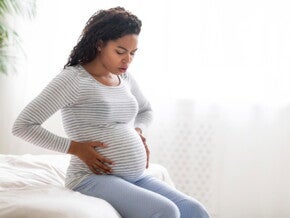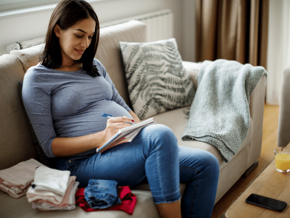
Maternity Leave Checklist
There’s a lot to think about when you’re planning maternity leave from work. Here are our tips to get you ready for your parental leave.
It might seem a while away, but once you’ve made your pregnancy announcement, it’s a good idea to begin pregnancy leave preparations and find out your maternity leave requirements, including if you’re entitled to maternity pay.
Your Checklist for Maternity Leave
1. Firstly, let your boss know the big news. They will be able to point you in the right direction for who to talk to in HR, and any other forms or procedures you need to follow. There is a minimum 10 week notice period for you to inform your employer in writing of your pregnancy, best to check their maternity leave requirements and policies.
2. You might need a risk assessment for your workplace, especially if you work in a manual job or with chemicals. Your employer will be able to make sure your workstation is ergonomic, and your activities are appropriate for a pregnant person.
3. Think about when you want to start your pregnancy leave. Some people prefer taking some pre-natal leave to rest at home well in advance of their due date. In Australia, maternity leave can start up to 6 weeks before your baby is due, however there is no reason you can’t extend this further if you have annual leave, you will just need to work that out with your employer. Others like to continue to work until much closer to their due date. Your healthcare professional will also be able to advise you if you need to have additional time off before your baby is born.
4. Consider how much time you want to take off work after baby arrives. It’s a very personal decision, and the right choice is different for everyone. The Australian Government has information online about your parental leave rights and your employer will also be able to provide you with your employee leave entitlements.
5. Work out how much maternity leave is affordable for you. There might be limitations to how much paid leave you are eligible for. Check with your employer about their parental leave which will be either paid or unpaid, and you might qualify for government assistance through Centrelink.
6. Have a plan for your return to work. Your employer will want to know what your plan is before you go on maternity leave. Some new parents decide to return to work part-time, and others full-time for a variety of reasons. When considering your return to work, discuss with your support network what your options are, and if you are going to use a daycare make sure you get onto waiting lists early.
7. Ask advice from friends, family and colleagues who have experienced maternity leave. They might have some pointers you haven’t thought of before.
8. Talk to your partner about if they want to also take parental leave. Some employers will allow both parents to go on primary parental leave one after the other, and the government may provide some leave for the secondary carer.
9. Ask your employer about keeping-in-touch days. In Australia, an employee gets 10 ‘keeping in touch’ days during 12 months of unpaid leave. They are a great opportunity for you to keep up to date with any key changes or policies, as well as catching up with your colleagues.
Now you’ve got that admin out of the way, you can reward yourself with a fun task—baby names! See our baby name generator for ideas.
Frequently asked questions about maternity leave
How long is maternity leave in Australia?
In Australia, maternity leave typically lasts for up to 12 months. Eligible employees are entitled to 52 weeks of unpaid leave, which may be taken as a continuous block or in shorter periods with your employer's agreement. Additionally, the government offers the Paid Parental Leave scheme, providing up to 18 weeks of pay at the national minimum wage. It's important to check with your employer and review the specific requirements and entitlements outlined in the Fair Work Act and other relevant legislation.
When should maternity leave start?
Maternity leave starts as soon as you take continuous leave before having a baby. The timing of when to start maternity or parental leave is a personal decision that depends on various factors, including your health, the nature of your job, and your personal circumstances. Many women choose to take some pre-natal leave and begin their leave between 2-6 weeks before they are due, or more if they experience discomfort or if their job is physically demanding. It's important to discuss your options with your doctor and employer to determine the best time to start your maternity leave based on your individual needs and any specific workplace policies.
What do I need to do before going on maternity leave?
There are a few important steps to consider before going on maternity leave, starting with talking with your employer about any specific policies, processes for applying for leave, or any other requirements in your workplace to ensure a smooth transition into maternity leave. In no particular order, other considerations may include exploring any available government benefits or parental leave programs; organising your finances to accurately plan for time of unpaid leave; planning your workload or any necessary handover training for the person covering your maternity leave; and setting up an out-of-office message to manage expectations.
How do you structure maternity leave?
Structuring parental leave is a personal decision based on individual circumstances. Consider factors like financial needs, bonding time, access to extra support from family or friends, and career aspirations. Plan your leave duration, communicate with your employer, and create a schedule that allows for a smooth transition. Flexibility and open communication are key.
How many weeks before my due date should I go on maternity leave?
The ideal time to start maternity leave varies for each individual and depends on personal circumstances, health, and job requirements. In general, many women choose to start their maternity leave around 2-6 weeks before their due date. This allows time for rest, preparation, and reduces the risk of feeling overwhelmed towards the end of pregnancy. However, it's important to consult with your doctor or midwife, and employer, to determine the best timing for your specific situation.
Is maternity leave and parental leave the same?
While they are both carers leave entitlements, they slightly differ in definition. Maternity leave specifically refers to the time off from work that is granted to a mother for the purpose of giving birth, recovering from childbirth, and bonding with a new baby. On the other hand, parental leave is a broader term that includes leave given to both mothers and fathers or other primary caregivers to care for a newborn or newly adopted child.
Sources:
- Pregnancy Birth and Baby website. Accessed at: https://www.pregnancybirthbaby.org.au/paid-parental-leave
- Australian Government Department of Social Services - Paid Parental Leave scheme. Accessed https://www.dss.gov.au/our-responsibilities/families-and-children/programs-services/paid-parental-leave-scheme
- Australian Government Fair Work Ombudsman website. Accessed at https://www.fairwork.gov.au/tools-and-resources/fact-sheets/minimum-workplace-entitlements/parental-leave-and-related-entitlements





